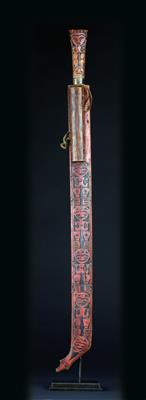Taiwan; tribe: Paiwan; A very rare ceremonial sword of the Paiwan, with eight ancestor figures.
Taiwan; tribe: Paiwan; A very rare ceremonial sword of the Paiwan, with eight ancestor figures.

An extremely rare, very well-preserved ceremonial sword of the Paiwan, called ‘tjakit’, from the island of Taiwan (earlier: Formosa). The sword has a single-edged iron blade. The hilt is attached to a ring made of brass. Hilt and sheath consist of wood and are richly carved in relief: the hilt displays on either side one ancestor figure with raised arms. Under each of these figures is a head (upside-down). The sheath is carved with four ancestor figures on the front side, one on top of the other and all in the same characteristic pose. Additionally, these ancestor figures are adorned with small brass studs. In the upper section the sheath features a long, carved projection for fastening the two short carrying strips. The sheath ends in a single head followed by the head of the highly poisonous snake known as ‘hundred-pacer’ (deinagkistrodon), which was the the object of ritual worship among the Paiwan. All the visible wooden sections in relief (handle and sheath) are dyed red and black. The reverse of the sheath is open and held together by means of thick, twisted brass wire.
Although today the term ‘Taiwan’ refers to the Republic of China (ROC), this was not always the case. Until the 17th century, the island of Taiwan was inhabited exclusively by nine tribes who had nothing to do with the Chinese on the mainland. From a cultural and anthropological perspective, these nine tribes had much more in common with the Ifugao of the Philippines to the south (they were head hunters, too!).
The Chinese came to the island of Taiwan over the course of three waves of immigration from the 17th century onwards. Today, the rest of the original population of Taiwan – including the tribe of the Paiwan – lives in small reservations at the heart of the island, surviving as a tourist attraction in ‘show villages’. Hardly anything still exists of its original culture. For this reason, a ceremonial ‘tjakit’ sword of the Paiwan is an extremely rare and valuable object.
Only very few comparable specimens still exist. 19th century. L: 74 cm. Published in ‘Art of the Ancestors’ by Thomas Murray, USA (catalogue). (ME)
Provenance: Brussels collection.
Lit.: ‘Material Culture of the Formosan Aborigines’ by Chen Chi-Lu, fig. 52; ‘Paiwan. Kunst und Kultur der Ureinwohner Taiwans’, The Hsu Ying-Chou Collection, Museum für Völkerkunde Wien (catalogue), ill. S-10.3, S-10.6, S-10.10.
Specialist: Erwin Melchardt
 Erwin Melchardt
Erwin Melchardt
+43-1-515 60-465
erwin.melchardt@dorotheum.at
05.11.2014 - 13:00
- Estimate:
-
EUR 9,000.- to EUR 10,000.-
Taiwan; tribe: Paiwan; A very rare ceremonial sword of the Paiwan, with eight ancestor figures.
An extremely rare, very well-preserved ceremonial sword of the Paiwan, called ‘tjakit’, from the island of Taiwan (earlier: Formosa). The sword has a single-edged iron blade. The hilt is attached to a ring made of brass. Hilt and sheath consist of wood and are richly carved in relief: the hilt displays on either side one ancestor figure with raised arms. Under each of these figures is a head (upside-down). The sheath is carved with four ancestor figures on the front side, one on top of the other and all in the same characteristic pose. Additionally, these ancestor figures are adorned with small brass studs. In the upper section the sheath features a long, carved projection for fastening the two short carrying strips. The sheath ends in a single head followed by the head of the highly poisonous snake known as ‘hundred-pacer’ (deinagkistrodon), which was the the object of ritual worship among the Paiwan. All the visible wooden sections in relief (handle and sheath) are dyed red and black. The reverse of the sheath is open and held together by means of thick, twisted brass wire.
Although today the term ‘Taiwan’ refers to the Republic of China (ROC), this was not always the case. Until the 17th century, the island of Taiwan was inhabited exclusively by nine tribes who had nothing to do with the Chinese on the mainland. From a cultural and anthropological perspective, these nine tribes had much more in common with the Ifugao of the Philippines to the south (they were head hunters, too!).
The Chinese came to the island of Taiwan over the course of three waves of immigration from the 17th century onwards. Today, the rest of the original population of Taiwan – including the tribe of the Paiwan – lives in small reservations at the heart of the island, surviving as a tourist attraction in ‘show villages’. Hardly anything still exists of its original culture. For this reason, a ceremonial ‘tjakit’ sword of the Paiwan is an extremely rare and valuable object.
Only very few comparable specimens still exist. 19th century. L: 74 cm. Published in ‘Art of the Ancestors’ by Thomas Murray, USA (catalogue). (ME)
Provenance: Brussels collection.
Lit.: ‘Material Culture of the Formosan Aborigines’ by Chen Chi-Lu, fig. 52; ‘Paiwan. Kunst und Kultur der Ureinwohner Taiwans’, The Hsu Ying-Chou Collection, Museum für Völkerkunde Wien (catalogue), ill. S-10.3, S-10.6, S-10.10.
Specialist: Erwin Melchardt
 Erwin Melchardt
Erwin Melchardt
+43-1-515 60-465
erwin.melchardt@dorotheum.at
|
Buyers hotline
Mon.-Fri.: 10.00am - 5.00pm
kundendienst@dorotheum.at +43 1 515 60 200 |
| Auction: | Tribal Art |
| Auction type: | Saleroom auction |
| Date: | 05.11.2014 - 13:00 |
| Location: | Vienna | Palais Dorotheum |
| Exhibition: | 31.10. - 05.11.2014 |
